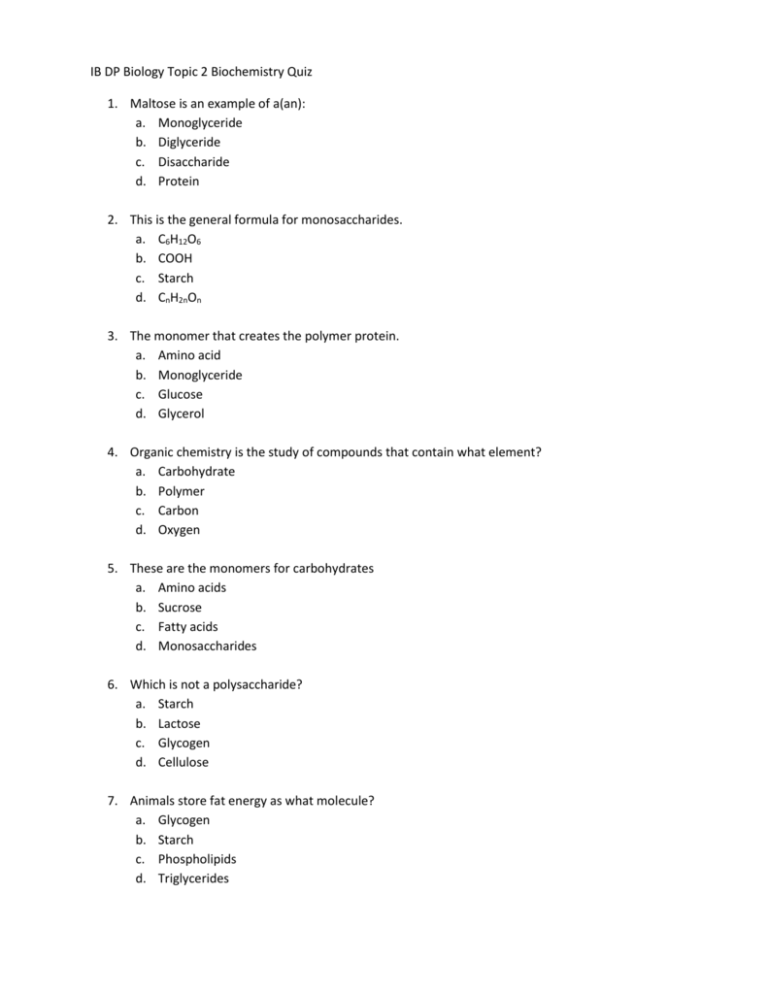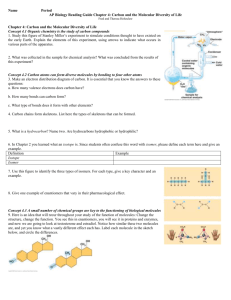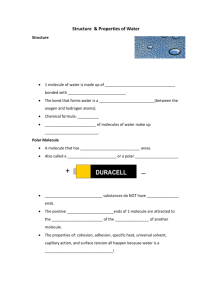IB DP Biology Topic 2 Biochemistry Quiz Maltose is an example of a
advertisement

IB DP Biology Topic 2 Biochemistry Quiz 1. Maltose is an example of a(an): a. Monoglyceride b. Diglyceride c. Disaccharide d. Protein 2. This is the general formula for monosaccharides. a. C6H12O6 b. COOH c. Starch d. CnH2nOn 3. The monomer that creates the polymer protein. a. Amino acid b. Monoglyceride c. Glucose d. Glycerol 4. Organic chemistry is the study of compounds that contain what element? a. Carbohydrate b. Polymer c. Carbon d. Oxygen 5. These are the monomers for carbohydrates a. Amino acids b. Sucrose c. Fatty acids d. Monosaccharides 6. Which is not a polysaccharide? a. Starch b. Lactose c. Glycogen d. Cellulose 7. Animals store fat energy as what molecule? a. Glycogen b. Starch c. Phospholipids d. Triglycerides 8. Cells use this type of molecule to increase the rate of a reaction. a. DNA b. Enzyme c. Lipid d. Nucleic acid 9. Catabolic reactions: a. Break down large molecules into smaller ones b. Involve condensation reactions c. Always involve carbohydrates d. Combine smaller molecules into larger ones 10. This type of reaction requires the addition of water as a reactant a. Condensation b. Hydrolysis c. Anabolic d. Enzyme 11. Glucose and fructose combine to form: a. The monosaccharide sucrose b. The disaccharide maltose c. The disaccharide sucrose d. The monosaccharide lactose 12 . Glycerol is a required molecule of the formation of: a. b. c. d. Fatty acids Diglyceride Polysaccharide Protein 13. An NH2 group will always be found as part of what type of molecule? a. amino acid b. fatty acid c. lipid d. organic 14. Water is polar because: a. b. c. d. The oxygen atom has a partially positive charge The hydrogen atoms are partially negative The hydrogen atoms are partially positive while the oxygen is partially negative It has a low boiling point 15. Cohesion is defined as: a. b. c. d. Water molecules being attracted to other polar molecules The hydrogen atoms in water covalently bonding to other water molecules Covalent bonding of oxygen atoms in water to other water molecules The hydrogen atoms in water bonding to the oxygen atoms in other water molecules by hydrogen bonding. 16. Water is able to climb to the tops of tall trees against the force of gravity due to: a. b. c. d. Cohesion Adhesion Both cohesion and adhesion Protein pumps 17. Water has a high heat of vaporization. This means water can absorb a great deal of heat when it does what? a. bonds to other molecules b .evaporates c. condenses d. dissolves things 18. Carbohydrates, proteins and ions are very soluble in water due to the fact that: a. b. c. d. Water is cohesive Water is polar Water has a high specific heat Water is adhesive 19. A monosaccharide with 5 carbons would be: a. b. c. d. A triose sugar A molecule with a molecular formula C6H12O6 Ribose A monomer of starch 20. Water is able to climb to the tops of tall trees against the force of gravity due to: a. b. c. d. Cohesion Adhesion Both cohesion and adhesion Protein pumps 21. This polysaccharide is composed of Beta glucose molecules a. b. c. d. Cellulose Starch Glycogen Chitin 22. Where would you expect to find a 1,6 glycosidic bond? a. b. c. d. Cohesion Triglyceride Glycogen Glycerol 23. All fatty acids have a carboxylic acid group (-COOH) at one end and what at the other? a. b. c. d. Amine Double bond Glycerol Methyl group (-CH3) 24. Which is true of most unsaturated fatty acids? a. b. c. d. Found in animal fats No double bonds Liquid at room temperature Generally are not good for you 25. An omega -3 monounsaturated fatty acid will have: a. b. c. d. 3 double bonds A double bond at carbon 3 3 glycerols No double bonds Which molecule is a: 26. Glycerol a. 1 b. 6 27. Saturated fatty acid c. 10 d. 14 a. 1 b. 4 28. Maltose a. 2 b. 8 c. 12 d. 15 29. Ribose a. 6 b. 12 c. 15 d. 13 b. 5 c. 6 d. 14 30. Amino acid a. 8 c. 7 d. 9









